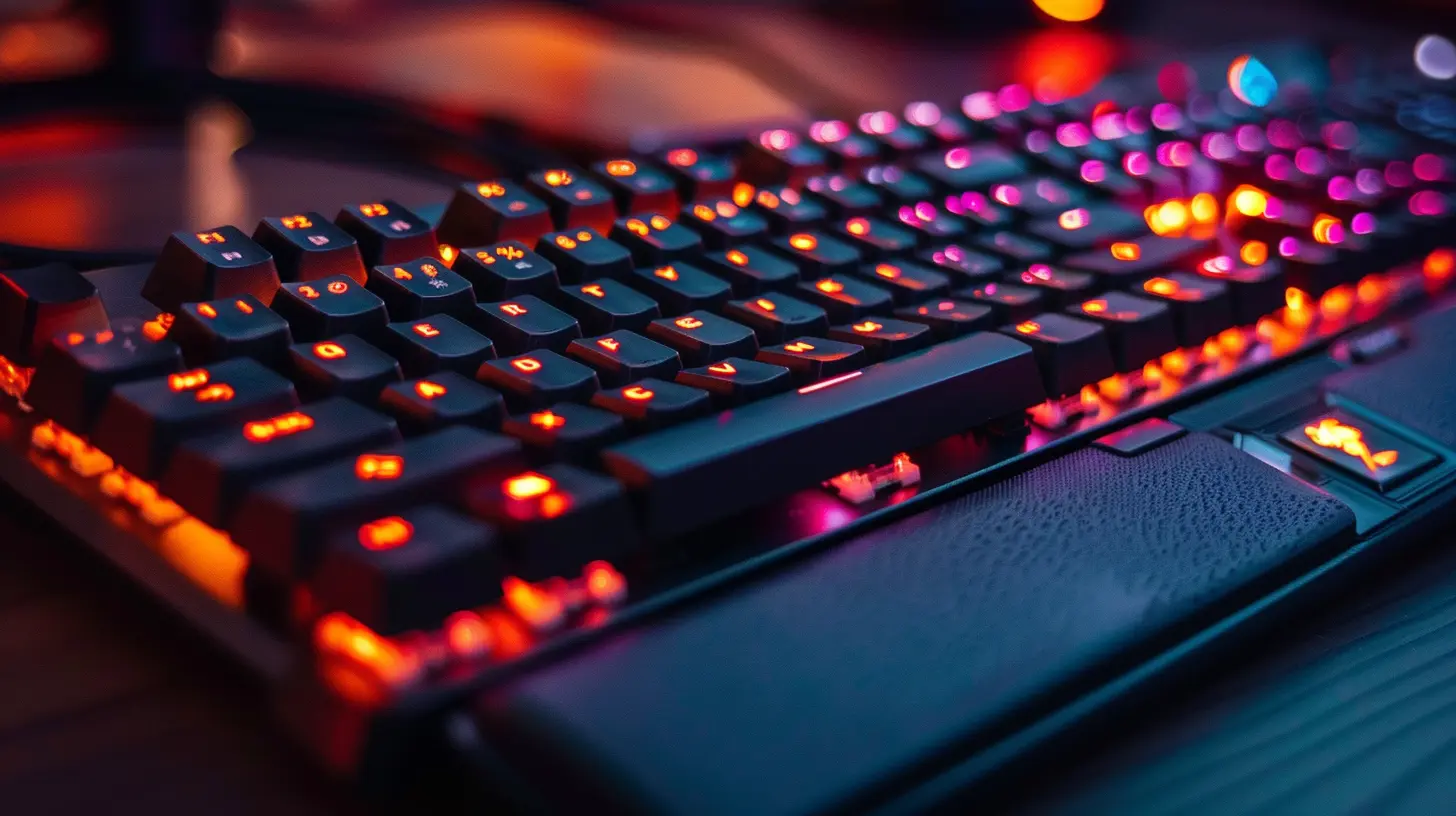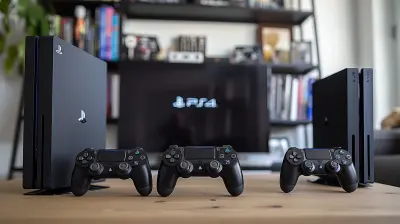How to Pick the Right Gaming Keyboard for Your Play Style
19 August 2025
If you're a gamer—and let's be real, if you're here, you probably are—you already know that your gear can make or break your game. Whether you're dodging bullets in a fast-paced FPS, commanding an army in an RTS, or diving deep into character-based MMORPGs, the right peripheral can take your performance from "meh" to "MVP." One of the most crucial tools in your digital arsenal? Your keyboard.
But with all the flashy lights, tech specs, and marketing buzzwords out there, picking the right gaming keyboard can feel like trying to solve a puzzle without all the pieces. Don't worry—I got you. In this guide, we’ll break it all down in a fun, simple, and totally non-nerdy (okay, slightly nerdy) way.

Why Your Gaming Keyboard Actually Matters
Let me ask you something—have you ever lost a close match because you hit the wrong key or your character moved a tad too late? Yeah, that’s what we call input lag, or even worse, ghosting. It happens more often than you think when you're using a keyboard that's not suited for your play style.Your gaming keyboard isn’t just a bunch of buttons. It’s your sword, your shield, your steering wheel—whatever metaphor fits your gaming style. It’s the connection between your thoughts and your actions in-game. Choosing the right one isn’t just about aesthetics; it can literally change the way you play.

Understanding the Different Gaming Keyboard Types
Before we get into the nitty-gritty, let’s cover the basics. Gaming keyboards generally fall into a few different categories, and knowing which one suits your gaming habits will save you a ton of buyer’s remorse later.1. Membrane Keyboards
These are the most common and cheapest keyboards you’ll find. They use a rubber dome under each key. When you press a key, it pushes down on the dome, which then presses onto a circuit and signals your computer.Pros:
- Affordable
- Quiet keystrokes
- Simple design
Cons:
- Slower response time
- Less tactile feedback
- Shorter lifespan
For casual gamers or those on a tighter budget, membrane keyboards can get the job done. But if you’re serious about upping your game, you might want to look elsewhere.
2. Mechanical Keyboards
Ah, the holy grail of gaming keyboards. Mechanical keyboards use individual mechanical switches for each key. That means better feedback, faster response, and a far more satisfying click (which can be a love-it-or-hate-it thing).Pros:
- Great tactile feedback
- Faster actuation
- Durable and long-lasting
- Tons of customization options
Cons:
- Pricier
- Louder (not office-friendly)
- Heavier and bulkier
If you're into competitive gaming or just love that old-school typing sound and feel, mechanical is probably your best bet.
3. Hybrid Keyboards
Hybrid keyboards combine the affordability of membrane keyboards with some of the tactile benefits of mechanical ones. They’re like the mullet of keyboards—business in the front, party in the back.Pros:
- Mid-range pricing
- Better feel than membrane
- Quieter than mechanical
Cons:
- Still not as responsive as full mechanical
- Limited customizability
These are perfect if you’re not quite ready to commit to full mechanical but still want more out of your keyboard.

Match Your Keyboard to Your Play Style
This is where the magic happens. Picking the right gaming keyboard means asking yourself what kind of games you play—and more importantly, how you play them.FPS (First-Person Shooter) Gamers
Reaction time is everything here. Whether you're flicking across the screen in CS:GO or sprinting through Warzone, you need a keyboard that responds as fast as you do.What to look for:
- Linear switches (like Cherry MX Red)
- Anti-ghosting and N-key rollover
- Compact or TKL design to save space for your mouse
A mechanical keyboard with fast, responsive switches will keep you a step ahead of your enemies. No delay, no excuses.
MMO/MOBA Enthusiasts
Macros, baby. If you’re tackling raids in WoW or dominating with combos in League of Legends, having programmable keys can give you a huge edge.What to look for:
- Keyboards with extra macro keys
- Software for key remapping
- Tactile switches (like Cherry MX Brown or Blue)
- RGB—because let’s face it, it looks cool and helps with key visibility
You need a keyboard that’s basically a control center. The more control you have, the better you'll dominate the battlefield.
Casual & Variety Gamers
Not everyone is in it to win esports tournaments. Maybe you enjoy laid-back sessions of Minecraft, Skyrim, or even the occasional strategy game.What to look for:
- Comfortable typing experience
- Durable build
- Aesthetic appeal (hey, it matters!)
- Decent key response
A hybrid or mid-range mechanical keyboard would be perfect here. You’ll get solid performance without overkill specs that you’ll never use.
Streamers & Content Creators
If you're on camera or recording voiceovers, a loud clicky keyboard might drive your viewers nuts. Or maybe you want that clack-clack-hype sound—totally your call.What to look for:
- Quiet or silent switches (like Cherry MX Silent Red)
- Sleek design for camera shots
- RGB lighting for ambiance
- USB passthroughs for convenience
Here, a mix of performance and aesthetics is key. After all, you're not just playing—you’re putting on a show.

Understanding Switch Types: It’s All in the Feel
Gaming keyboards aren’t just about look and layout—switches are where it gets real. This is where you'll feel the difference between "good enough" and "holy smokes, this is smooth."Most Popular Switch Types:
- Linear (e.g., Cherry MX Red) – Smooth keystrokes, no tactile bump. Great for FPS gamers who want fast response times.- Tactile (e.g., Cherry MX Brown) – Slight bump on keystroke. Best for gamers who need feedback but don’t want loud clicks.
- Clicky (e.g., Cherry MX Blue) – Audible click and tactile bump. Satifying for typing, but can be distracting.
- Silent (e.g., Cherry MX Silent Red) – Like linear, but dampened for extra quiet gaming.
Each switch type impacts how you game. Some feel like butter, others like a typewriter. The best way to decide? Try them out if you can. Many stores have demo boards just for this reason.
Form Factor: Size Matters
Keyboards come in different shapes and sizes. Bigger isn’t always better—it all depends on what you need and how you use it.Full-Sized Keyboards
These pack everything in—function row, number pad, arrow keys, and sometimes even a few extras.Best for: MMO gamers, spreadsheet lovers, and people who don’t mind a big footprint.
Tenkeyless (TKL)
No number pad, but everything else stays. Great for saving desk space and giving you more room for mouse movement.Best for: FPS or MOBA players who need more room to maneuver.
60% or Compact Keyboards
Super minimalist—no function row, no arrow keys, no numpad. Looks clean, works great with limited space.Best for: Streamers, minimalist setups, and gamers who value portability.
Must-Have Features for Serious Gamers
There are some bells and whistles that are actually super useful—not just marketing fluff. Here are the features that can make a real difference.- RGB Lighting: Not just for show. Customizable lighting zones can help you find keys faster and create immersive effects.
- Programmable Macros: Crucial for MMOs or any game where combos matter.
- USB/Audio Passthrough: Plug in your mouse or headset directly into the keyboard. Super convenient.
- Wrist Rest: Comfort is key during long gaming sessions.
- Durable Build: Look for aluminum top plates and high-quality keycaps.
Budgeting: Get the Best Bang for Your Buck
Gaming keyboards range from $30 to $300+. The good news? You don’t have to shell out half your paycheck to get something solid. Set a budget, figure out your must-have features, and filter out the noise.Ask yourself:
- Do I need a mechanical keyboard or will a solid membrane do?
- Am I paying extra for aesthetics, or features I’ll actually use?
- Will I be gaming casually, or do I want to go pro?
Don’t feel pressured to grab the most expensive model. Performance doesn’t always scale with price.
Final Thoughts: It’s All About You
At the end of the day, the best gaming keyboard for your play style is the one that feels right to you. Don’t get caught up in the hype or overloaded by specs—go with something that complements how you game.Your keyboard should feel like an extension of your hands, like a trusty sidekick in your gaming journey. When you find the right one, you’ll know it. You'll move faster, aim sharper, and game harder. Whether you're climbing the ranks, creating content, or just having fun—your keyboard should help you do it better.
So go ahead, grab a coffee (or an energy drink), browse some models, and pick a keyboard that fits your play style like a glove. Then get ready—because your next-level gameplay is just a keystroke away.
all images in this post were generated using AI tools
Category:
Gaming HardwareAuthor:

Lana Johnson
Discussion
rate this article
1 comments
Easton McKeever
In the labyrinth of gaming peripherals, the right keyboard can be your secret weapon or your greatest downfall. But beware: hidden beneath the glimmer of RGB lights lies a deeper choice. Will you forge a symbiotic bond with your keys, or remain a mere pawn in the game? Choose wisely.
September 4, 2025 at 3:43 AM

Lana Johnson
Absolutely! The right keyboard enhances your gameplay and comfort, so be sure to align it with your play style for the best experience. Choose wisely!


